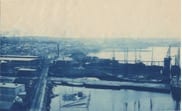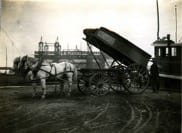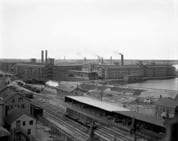


Online talk to reveal industrial evolution of Port of New Bedford in photos
September 8, 2020
Accompanies outdoor exhibition Inside Out! The River and the Rail
New Bedford Whaling Museum
NEW BEDFORD, Mass. — The Port of New Bedford, Massachusetts has transformed itself many times in the past, adapting to change in order to survive and thrive. During an online curator talk on September 22, 2020, Michael P. Dyer, New Bedford Whaling Museum Curator of Maritime History, will use historical photographs from the Whaling Museum’s archives to take participants on a trip through time, from the waning days of whaling to the rise of coal and manufacturing industries, and on to the demise and re-birth of the mills. The photographs are featured in the Inside Out! outdoor exhibition The River and the Rail: The Industrial Evolution of the Port of New Bedford, opening September 17. This live online event begins at 6:00 p.m. and is free to attend, but registration is required. Details and registration information are available at www.whalingmuseum.org.
The historical photographs reveal some of the changes seen along the New Bedford waterfront from the late 19th century through the mid-20th century. By 1890, large schooners, barges and steamers, carrying coal, cotton and lumber, were replacing whale ships on New Bedford’s waterfront. As whaling declined, the industry left valuable infrastructure in its wake: wharves and a railroad. Coal was becoming the primary energy source used to power growing manufacturing facilities, including textile mills and other heavy industry. Millions of feet of cotton textiles were shipped to market via rail, and millions of tons of coal moved through the port to feed textile mills and, by the early 20th century, to heat homes. Mills began to close in the 1960s, coal storage structures or pockets disappeared, and the railroad stopped running.
While the train tracks remain, there is no evidence of the coal industry in New Bedford today, and the gigantic mills are being torn down or re-purposed as the port once again adapts to change.
The exhibition The River and the Rail: The Industrial Evolution of the Port of New Bedford is part of the Whaling Museum’s Inside Out! series of rotating outdoor exhibitions on the Museum’s plaza at the corner of Johnny Cake Hill and William Street in New Bedford, Mass. The series is supported in part by BayCoast Bank. Inside Out! The River and the Rail will be on view daily, free of charge, September 17- September 30, 2020. The Whaling Museum’s galleries are open Wednesday through Sunday, 10:00 a.m. through 4:00 p.m. Details are available at www.whalingmuseum.org.
DOWNLOAD IMAGES AT https://photos.app.goo.gl/eNzLDkB3eqPP3zDr8
Contact
Evan England
Managing Director, NAIL[PR]
eengland@nailpr.cc
(401) 753-5588
About the New Bedford Whaling Museum
The New Bedford Whaling Museum ignites learning through explorations of art, history, science and culture rooted in the stories of people, the region and an international seaport. The cornerstone of New Bedford Whaling National Historical Park, the Museum is located at 18 Johnny Cake Hill in the heart of the city’s historic downtown. The Museum is open daily from 9 a.m. to 5 p.m. Admission is free for Whaling Museum members and children ages three and under; adults $19, seniors (65+) $17, students (19+) $12, child and youth $9. For more information visit www.whalingmuseum.org.

